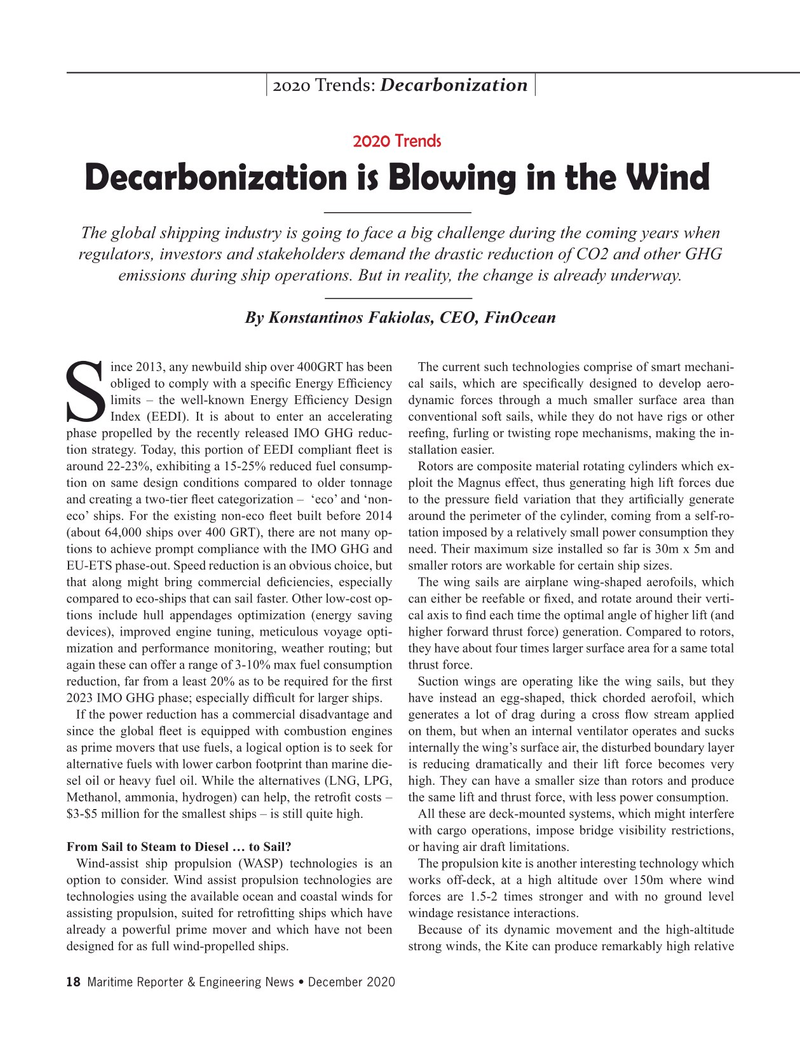
Page 18: of Maritime Reporter Magazine (December 2020)
Great Ships of 2020
Read this page in Pdf, Flash or Html5 edition of December 2020 Maritime Reporter Magazine
2020 Trends: Decarbonization 2020 Trends
Decarbonization is Blowing in the Wind
The global shipping industry is going to face a big challenge during the coming years when regulators, investors and stakeholders demand the drastic reduction of CO2 and other GHG emissions during ship operations. But in reality, the change is already underway.
By Konstantinos Fakiolas, CEO, FinOcean ince 2013, any newbuild ship over 400GRT has been The current such technologies comprise of smart mechani- obliged to comply with a speci? c Energy Ef? ciency cal sails, which are speci? cally designed to develop aero- limits – the well-known Energy Ef? ciency Design dynamic forces through a much smaller surface area than
Index (EEDI). It is about to enter an accelerating conventional soft sails, while they do not have rigs or other
S phase propelled by the recently released IMO GHG reduc- ree? ng, furling or twisting rope mechanisms, making the in- tion strategy. Today, this portion of EEDI compliant ? eet is stallation easier.
around 22-23%, exhibiting a 15-25% reduced fuel consump- Rotors are composite material rotating cylinders which ex- tion on same design conditions compared to older tonnage ploit the Magnus effect, thus generating high lift forces due and creating a two-tier ? eet categorization – ‘eco’ and ‘non- to the pressure ? eld variation that they arti? cially generate eco’ ships. For the existing non-eco ? eet built before 2014 around the perimeter of the cylinder, coming from a self-ro- (about 64,000 ships over 400 GRT), there are not many op- tation imposed by a relatively small power consumption they tions to achieve prompt compliance with the IMO GHG and need. Their maximum size installed so far is 30m x 5m and
EU-ETS phase-out. Speed reduction is an obvious choice, but smaller rotors are workable for certain ship sizes.
that along might bring commercial de? ciencies, especially The wing sails are airplane wing-shaped aerofoils, which compared to eco-ships that can sail faster. Other low-cost op- can either be reefable or ? xed, and rotate around their verti- tions include hull appendages optimization (energy saving cal axis to ? nd each time the optimal angle of higher lift (and devices), improved engine tuning, meticulous voyage opti- higher forward thrust force) generation. Compared to rotors, mization and performance monitoring, weather routing; but they have about four times larger surface area for a same total again these can offer a range of 3-10% max fuel consumption thrust force.
reduction, far from a least 20% as to be required for the ? rst Suction wings are operating like the wing sails, but they 2023 IMO GHG phase; especially dif? cult for larger ships. have instead an egg-shaped, thick chorded aerofoil, which
If the power reduction has a commercial disadvantage and generates a lot of drag during a cross ? ow stream applied since the global ? eet is equipped with combustion engines on them, but when an internal ventilator operates and sucks as prime movers that use fuels, a logical option is to seek for internally the wing’s surface air, the disturbed boundary layer alternative fuels with lower carbon footprint than marine die- is reducing dramatically and their lift force becomes very sel oil or heavy fuel oil. While the alternatives (LNG, LPG, high. They can have a smaller size than rotors and produce
Methanol, ammonia, hydrogen) can help, the retro? t costs – the same lift and thrust force, with less power consumption.
$3-$5 million for the smallest ships – is still quite high. All these are deck-mounted systems, which might interfere with cargo operations, impose bridge visibility restrictions,
From Sail to Steam to Diesel … to Sail? or having air draft limitations.
Wind-assist ship propulsion (WASP) technologies is an The propulsion kite is another interesting technology which option to consider. Wind assist propulsion technologies are works off-deck, at a high altitude over 150m where wind technologies using the available ocean and coastal winds for forces are 1.5-2 times stronger and with no ground level assisting propulsion, suited for retro? tting ships which have windage resistance interactions.
already a powerful prime mover and which have not been Because of its dynamic movement and the high-altitude designed for as full wind-propelled ships. strong winds, the Kite can produce remarkably high relative 18 Maritime Reporter & Engineering News • December 2020
MR #12 (18-33).indd 18 12/4/2020 8:44:47 AM

 17
17

 19
19
